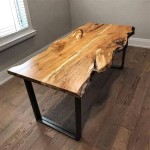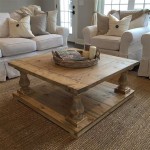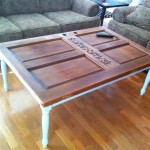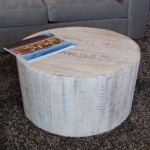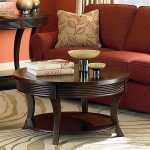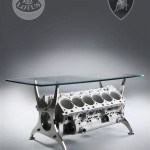How to Lighten a Dark Coffee Table
Dark coffee tables, while offering a sense of sophistication and grounding in a living space, can sometimes make a room feel smaller and less inviting. Lightening a dark coffee table can significantly brighten the surrounding area and create a more airy and open ambiance. This article explores several effective methods to achieve a lighter look for a dark coffee table, ranging from simple cleaning and polishing to more involved techniques like painting, staining, and applying decorative finishes.
Before embarking on any lightening project, it is crucial to assess the coffee table's current finish, material composition (wood, metal, glass, or laminate), and overall condition. This initial assessment will determine the most appropriate methods and products to use, ensuring the desired outcome and minimizing potential damage to the piece. The level of effort and expertise required will also vary depending on the chosen method.
Assessing the Coffee Table
The first step in lightening a dark coffee table is a thorough assessment. This involves identifying the existing finish, the material of the table, and any existing damage or imperfections. Identifying the finish is important as it will dictate the types of products and techniques that can be safely used. Common finishes include varnish, lacquer, polyurethane, stain, and paint. A simple test can help determine the type of finish. Applying a small amount of denatured alcohol to an inconspicuous area and observing its effect can provide clues. Varnish and lacquer will typically dissolve or become sticky, while polyurethane is more resistant. If unsure, consulting with a professional furniture refinisher is recommended.
The material of the coffee table also needs consideration. Solid wood tables can withstand more aggressive treatments like sanding and staining. Veneer tables, on the other hand, require a gentler approach to avoid damaging or removing the thin layer of wood. Metal tables may require specialized primers and paints designed for metal surfaces. Glass tables present a unique challenge and are often lightened by changing the base or adding decorative film rather than altering the glass itself. Laminate tables often mimic wood grain but lack the absorbent properties of solid wood or veneer, making staining ineffective. Painting is often the best option for laminate surfaces, preceded by proper priming.
Finally, assess the coffee table for any existing damage, such as scratches, dents, or watermarks. These imperfections should be addressed before applying any lightening techniques as they will become more noticeable if left untreated. Minor scratches can often be repaired with furniture polish or touch-up markers. Deeper scratches or dents may require wood filler or professional repair.
Cleaning and Polishing Techniques
Sometimes, a simple cleaning and polishing routine can significantly lighten the appearance of a dark coffee table, especially if the darkness is due to accumulated dirt, dust, and grime. Over time, these elements can dull the finish and obscure the natural beauty of the wood. A thorough cleaning can restore the original luster and reveal a lighter tone underneath.
Begin by dusting the coffee table with a soft cloth or duster. Pay attention to corners and crevices where dust tends to accumulate. Next, prepare a cleaning solution using mild soap and warm water. Avoid using harsh chemicals or abrasive cleaners, as these can damage the finish. Dip a soft cloth into the solution, wring it out thoroughly, and gently wipe down the entire surface of the table. Be careful not to saturate the wood, as excessive moisture can cause warping or staining.
After cleaning, rinse the table with a damp cloth to remove any soap residue. Dry the surface thoroughly with a clean, dry cloth. Once the table is completely dry, apply a high-quality furniture polish. Choose a polish that is appropriate for the finish of the table. Follow the manufacturer's instructions for application. Typically, the polish is applied with a soft cloth and buffed to a shine. Polishing not only enhances the appearance of the table but also provides a protective layer against future dirt and grime.
For coffee tables with stubborn stains or watermarks, you can try making a paste of baking soda and water. Apply the paste to the affected area, let it sit for a few minutes, and then gently rub it with a soft cloth. Rinse the area with a damp cloth and dry thoroughly. Repeat as needed until the stain is removed. Another option is to use a commercial stain remover designed for furniture. Always test the product in an inconspicuous area first to ensure it does not damage the finish.
Painting, Staining, and Finishing Techniques
For more drastic lightening, painting or staining a dark coffee table offers significant transformation potential. These methods allow for a complete color change, enabling a lighter, brighter aesthetic. However, these techniques require careful preparation and execution to achieve professional-looking results.
If painting the coffee table, begin by sanding the surface to create a smooth, even base. This is especially important if the table has a glossy finish, as sanding will help the paint adhere better. Use a medium-grit sandpaper to remove any existing finish and smooth out any imperfections. Wipe away the sanding dust with a tack cloth before proceeding. Apply a primer specifically designed for the material of the coffee table. Primer helps the paint adhere to the surface and provides a uniform base color. Allow the primer to dry completely according to the manufacturer's instructions. Then, apply two or more coats of paint, allowing each coat to dry thoroughly before applying the next. Choose a paint color that complements the existing décor of the room. Lighter shades of white, cream, or gray are popular choices for lightening a dark coffee table. Once the paint is completely dry, apply a clear topcoat to protect the finish and add durability.
If staining the coffee table, the existing finish must first be completely removed. This can be accomplished by sanding or using a chemical stripper. Follow the manufacturer's instructions carefully when using a chemical stripper, and always wear appropriate safety gear. Once the old finish is removed, sand the surface smooth and wipe away the sanding dust. Apply the stain evenly, using a brush or cloth. Allow the stain to penetrate the wood for the recommended amount of time, and then wipe away any excess stain. Apply multiple coats of stain to achieve the desired color intensity. Once the stain is completely dry, apply a clear topcoat to protect the finish and add durability. Choose a stain color that complements the natural grain of the wood. Lighter shades of stain, such as honey oak or natural pine, can effectively lighten a dark coffee table.
Decorative finishes, such as distressing or antiquing, can also be used to lighten the appearance of a dark coffee table. Distressing involves intentionally damaging the finish to create a worn, aged look. This can be accomplished by sanding, scratching, or hammering the surface of the table. Antiquing involves applying a glaze or stain to highlight the details and imperfections of the table. These techniques can add character and visual interest to the coffee table while also lightening its overall appearance.
When working with paints, stains, and finishes, it is essential to work in a well-ventilated area and wear appropriate safety gear, such as gloves and a mask. Always follow the manufacturer's instructions carefully, and test the products in an inconspicuous area before applying them to the entire table.
Alternative Surface Treatments
Beyond traditional methods like painting and staining, several alternative surface treatments can lighten a dark coffee table and introduce unique visual elements. These treatments may offer a more subtle approach or cater to specific aesthetic preferences. These include applying textured finishes, decoupage, or even decorative films.
Textured finishes can add depth and dimension to the coffee table, effectively breaking up the dark surface. Techniques like applying chalk paint and then lightly sanding to reveal the layers beneath can create a unique, distressed look. Similarly, using a textured roller when applying paint can create a subtle pattern that reflects light and lightens the overall appearance. Applying a crackle finish can also add visual interest and lighten the table by revealing lighter tones underneath the cracked surface.
Decoupage involves adhering decorative paper or fabric to the surface of the coffee table and then sealing it with a clear finish. This technique offers endless possibilities for customization and personalization. Light-colored or patterned paper or fabric can be used to lighten the table and create a unique focal point in the room. Images, maps, or even fabric scraps can be used to create a collage effect. The decoupage material is adhered to the table surface using a specialized decoupage glue or Mod Podge. Once the glue is dry, several coats of clear sealant are applied to protect the surface and create a smooth, durable finish.
Decorative films offer another option for lightening a dark coffee table without permanently altering the original finish. These films are available in a wide range of colors, patterns, and textures. They can be easily applied to the surface of the table and can be removed without damaging the underlying finish. This is a good option for renters or those who want to experiment with different looks without making a permanent commitment. Decorative films are particularly useful for lightening glass-topped coffee tables, as they can be applied to the underside of the glass to create a frosted or patterned effect.
Regardless of the chosen method, patience and attention to detail are key to achieving a successful outcome. Thorough preparation, careful application, and proper drying times are essential for creating a lightened coffee table that is both beautiful and durable. With the right techniques and materials, transforming a dark coffee table into a lighter, brighter piece can significantly enhance the overall aesthetic of the living space.

How To Simply Lighten Stained Wood 3 Helpful Tools Open Doors Hearts

How To Simply Lighten Stained Wood 3 Helpful Tools Open Doors Hearts

How To Simply Lighten Stained Wood 3 Helpful Tools Open Doors Hearts
Stripping A Table Method For Lightening Dark Wood Furniture Joyfully Treasured

How To Simply Lighten Stained Wood 3 Helpful Tools Open Doors Hearts

Coffee Table Makeover At Home With The Barkers

Brighten Up Your Dark Furniture Free Coffee Table Makeover

How To Simply Lighten Stained Wood 3 Helpful Tools Open Doors Hearts

5 Simple Steps To Paint And Transform Any Piece Of Dark Furniture Recreated Designs
Stripping A Table Method For Lightening Dark Wood Furniture Joyfully Treasured
Related Posts

